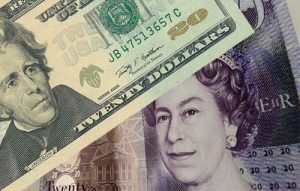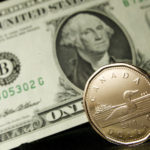 Yesterday’s trade saw GBP/USD within the range of 1.4333-1.4468. The pair closed at 1.4444, rising 0.57% on a daily basis. It has been the 19th gain in the past 37 trading days and also the sharpest one since April 26th, when the pair went up 0.69%. The daily low has been the lowest level since April 22nd, when a low of 1.4310 was registered. The major pair has pared its slump to 0.68% so far during the current month, following two consecutive months of advance.
Yesterday’s trade saw GBP/USD within the range of 1.4333-1.4468. The pair closed at 1.4444, rising 0.57% on a daily basis. It has been the 19th gain in the past 37 trading days and also the sharpest one since April 26th, when the pair went up 0.69%. The daily low has been the lowest level since April 22nd, when a low of 1.4310 was registered. The major pair has pared its slump to 0.68% so far during the current month, following two consecutive months of advance.
At 6:21 GMT today GBP/USD was edging up 0.23% on the day to trade at 1.4477. The pair touched a daily high at 1.4493 during mid-Asian trading session, overshooting the range resistance (R3), and a daily low at 1.4398 during the early phase of Asian trade.
On Tuesday GBP/USD trading may be influenced by the following macroeconomic reports and other events as listed below.
Fundamentals
United Kingdom
Consumer Price Index
The annual rate of inflation in the United Kingdom probably remained at 0.5% for a second straight month in April, according to the median estimate by experts. If so, it would be the 27th consecutive month, when annualized consumer prices remained below the 2-percent objective, set by the Bank of England. However, it has been the highest rate of inflation since December 2014, when the annualized CPI rose 0.5%.
In March upward pressure to consumer prices came from cost of housing and utilities (up 0.4% year-on-year, following a 0.3% gain in February). An additional upward impulse came from prices at restaurants and hotels (up 2.1% and following a 1.9% surge in February) and cost of miscellaneous goods and services (up 1.0% and following a 1.2% increase in the preceding month), according to the report by the Office for National Statistics. Consumers paid more also for clothing and footwear (up 1.4% year-on-year and accelerating from a 0.3% gain in February).
On the other hand, in March downward pressure to the Consumer Price Index came from cost of transport (down 0.1% year-on-year after a 1.1% drop in February), recreation and culture (down 0.2% and accelerating from a 0.1% drop in the prior month) and food and non-alcoholic beverages (down 2.7% year-on-year and accelerating from a 2.3% drop in February).
The annualized core consumer price inflation probably remained at 1.5% for a second straight month in April, according to market expectations. It has been the highest annual core inflation since September 2014, when the respective CPI was reported to have risen 1.5%. In January the Core Consumer Price Index increased at an annual rate of 1.2%. This indicator measures the change in prices of goods and services purchased by consumers, without taking into account volatile components such as food, energy products, alcohol and tobacco.
In case the annual CPI came in line with expectations or further approached the central bank’s inflation objective, this would have a strong bullish effect on the pound. The Office for National Statistics (ONS) will publish the official CPI report at 8:30 GMT.
United States
Housing Starts, Building Permits
The number of housing starts in the United States probably rose 2.9% to 1.129 million units in April, according to market expectations, from the seasonally adjusted annual rate of 1.089 million during the prior month. The latter has been the lowest number of starts since October 2015, when a revised up level of 1.062 million was reported. In March starts of single-family houses decreased at a monthly rate of 9.2% to 764 000, or the lowest figure since last October, while starts of buildings with five units or more were 8.5% fewer to reach 312 000. The latter has been the lowest figure in at least 1 year. In March, housing starts fell in the Midwest (down 25.4% month-over-month), in the West (down 15.7%) and in the South (down 8.4%). On the other hand, housing starts were more in the Northeast during the period (up 61.3% from a month ago).
Housing starts represent a gauge to measure residential units, on which construction has already begun every month. A start in construction is defined as the foundation laying of a building and it encompasses residential housing primarily.
The number of building permits in the country probably went up 4.3% to 1.130 million in April from an annual level of 1.086 million in March. The latter has been the lowest figure since March 2015, when a revised down level of 1.038 million was reported. Single-family authorizations fell at a monthly rate of 1.2% to reach 727 000 units in March, while permits of units in buildings with five units or more were reported to have slumped 20.6% to 324 000.
Building permits are permits, issued in order to allow excavation. An increase in the number of building permits and housing starts usually occurs a few months after mortgage rates in the country have been reduced. Authorizations are not required in all regions of the United States. Building permits, as an indicator, also provide clues in regard to demand in the US housing market. In case a higher-than-anticipated figure is reported, this would have a moderate bullish effect on the US dollar. The official housing data are due out at 12:30 GMT.
Consumer Price Index
The annualized consumer inflation in the United States probably accelerated to 1.1% in April, according to market expectations, from 0.9% in March. The latter has been the lowest level of consumer inflation since December 2015. In monthly terms, the Consumer Price Index (CPI) probably rose 0.3% in April, following a 0.1% uptick in the preceding month.
In March upward pressure came from cost of services less energy (up 3.0% year-on-year and following a 3.1% surge in February). Within the category, cost of shelter went up 3.2% year-on-year, cost of medical care rose 3.6%. Additionally, consumers paid more for food in March (up at an annualized rate of 0.8%, slowing down from a 0.9% surge in February) and transportation (up 2.8% year-on-year and matching the gain rate in February), according to the report by the Bureau of Labor Statistics. The largest downward pressure on the annual CPI came from prices of energy (down 12.6% in March from a year ago, or a steeper decline compared to February).
The annualized core consumer inflation, which is stripped of prices of food and energy, probably slowed down to 2.1% in April, according to expectations, from 2.2% in March. If so, it would be the lowest core inflation since December 2015.
If the general CPI tends to approach the inflation objective, set by the Federal Reserve and considered as providing price stability, or a level below but close to 2%, this will usually bolster the appeal of the US dollar, as it heightens the probability of monetary policy tightening.
The Bureau of Labor Statistics is to release the official CPI report at 12:30 GMT.
Industrial Production
Industrial output in the United States probably rose at a monthly rate of 0.3% in April, according to market expectations, following a 0.6% contraction in the prior month, or the largest since November 2015.
In March output in the US mining sector decreased 2.9%, or the most since September 2008. Considerable cutbacks in coal mining and in oil and gas well drilling and servicing, as well as lower oil and natural gas extraction contributed to the drag in the sector.
The gauge for utilities registered a 1.2% monthly decrease in March, due to a 4.6% slump in natural gas utilities.
Manufacturing production, which accounts for almost three quarters of total industrial production, shrank 0.3% in March, as production of durables decreased 0.4%, while that of non-durables edged down 0.1%.
In case the index of industrial production rebounded at a faster rate than anticipated in April, this would have a moderate bullish effect on the US dollar. The Board of Governors of the Federal Reserve is to release the production data at 13:15 GMT.
Fed Speakers
At 16:00 GMT the Fed President for San Francisco and also a FOMC member, John Williams, as well as the Fed President for Atlanta, Dennis Lockhart, are expected to take a statement. At 17:15 GMT, the Fed President for Dallas and also a FOMC member, Robert Kaplan, is expected to speak. Their remarks will be closely paid attention to by market players for hints over how the Banks policy tightening cycle will continue in the future.
Daily and Weekly Pivot Levels
By employing the Camarilla calculation method, the daily pivot levels for GBP/USD are presented as follows:
R1 – 1.4456
R2 – 1.4469
R3 (range resistance) – 1.4481
R4 (range breakout) – 1.4518
S1 – 1.4432
S2 – 1.4419
S3 (range support) – 1.4407
S4 (range breakout) – 1.4370
By using the traditional method of calculation again, the weekly pivot levels for GBP/USD are presented as follows:
Central Pivot Point – 1.4410
R1 – 1.4482
R2 – 1.4602
R3 – 1.4674
S1 – 1.4290
S2 – 1.4218
S3 – 1.4098





